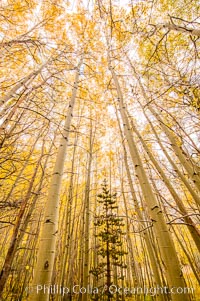
Quaking Aspen Trees, Sierra Nevada Fall Colors, Bishop Creek Canyon.
Species: Quaking aspen, Populus tremuloides
Location: Bishop Creek Canyon, Sierra Nevada Mountains, California
Image ID: 36443
Species: Quaking aspen, Populus tremuloides
Location: Bishop Creek Canyon, Sierra Nevada Mountains, California
Image ID: 36443
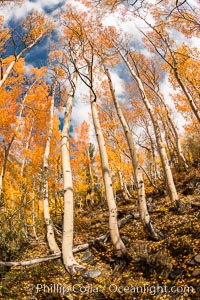
Aspen Trees and Sierra Nevada Fall Colors, Bishop Creek Canyon.
Species: Quaking aspen, Populus tremuloides
Location: Bishop Creek Canyon, Sierra Nevada Mountains, California
Image ID: 36447
Species: Quaking aspen, Populus tremuloides
Location: Bishop Creek Canyon, Sierra Nevada Mountains, California
Image ID: 36447
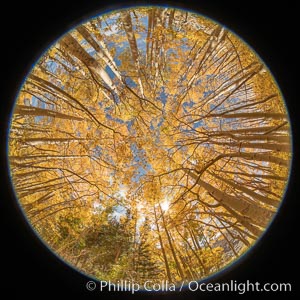
Aspen Trees and Sierra Nevada Fall Colors, Bishop Creek Canyon.
Species: Quaking aspen, Populus tremuloides
Location: Bishop Creek Canyon, Sierra Nevada Mountains, California
Image ID: 36450
Species: Quaking aspen, Populus tremuloides
Location: Bishop Creek Canyon, Sierra Nevada Mountains, California
Image ID: 36450
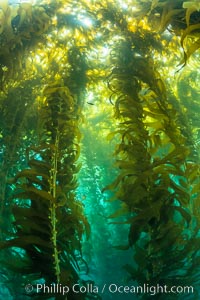
Sunlight glows throughout a giant kelp forest. Giant kelp, the fastest growing plant on Earth, reaches from the rocky reef to the ocean's surface like a submarine forest.
Species: Giant kelp, Macrocystis pyrifera
Location: San Clemente Island, California
Image ID: 37086
Species: Giant kelp, Macrocystis pyrifera
Location: San Clemente Island, California
Image ID: 37086
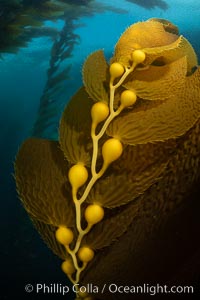
Kelp fronds and pneumatocysts. Pneumatocysts, gas-filled bladders, float the kelp plant off the ocean bottom toward the surface and sunlight, where the leaf-like blades and stipes of the kelp plant grow fastest. Giant kelp can grow up to 2' in a single day given optimal conditions. Epic submarine forests of kelp grow throughout California's Southern Channel Islands.
Species: Giant kelp, Macrocystis pyrifera
Location: San Clemente Island, California
Image ID: 37100
Species: Giant kelp, Macrocystis pyrifera
Location: San Clemente Island, California
Image ID: 37100
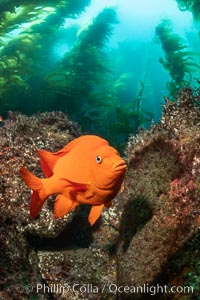
Garibaldi maintains a patch of algae (just in front of the fish) to entice a female to lay a clutch of eggs.
Image ID: 37144
Image ID: 37144
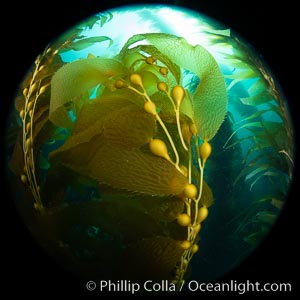
Kelp fronds and pneumatocysts. Pneumatocysts, gas-filled bladders, float the kelp off the ocean bottom toward the surface and sunlight, where the leaf-like blades and stipes of the kelp plant grow fastest.
Species: Giant kelp, Macrocystis pyrifera
Location: Catalina Island, California
Image ID: 37297
Species: Giant kelp, Macrocystis pyrifera
Location: Catalina Island, California
Image ID: 37297
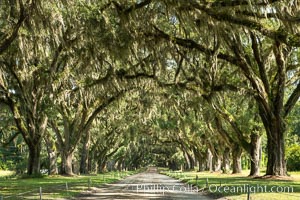
Southern Live Oaks form a long shaded Oak Alley at Wormsloe Plantation, Savannah, Georgia. Wormsloe State Historic Site.
Species: Southern live oak, Quercus virginiana
Location: Wormsloe Plantation, Savannah, Georgia
Image ID: 37384
Species: Southern live oak, Quercus virginiana
Location: Wormsloe Plantation, Savannah, Georgia
Image ID: 37384
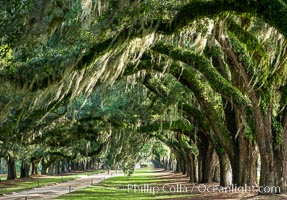
Oak Alley at Boone Hall Plantation, a shaded tunnel of huge old southern live oak trees, Charleston, South Carolina. Plantation owners planted long palisades of Southern Live Oaks to provide a shaded, cool allee (from the French) on which they could stroll, entertain and find diversion from the intense heat of the South.
Species: Southern live oak, Quercus virginiana
Location: Boone Hall Plantation, Charleston, South Carolina
Image ID: 37394
Species: Southern live oak, Quercus virginiana
Location: Boone Hall Plantation, Charleston, South Carolina
Image ID: 37394
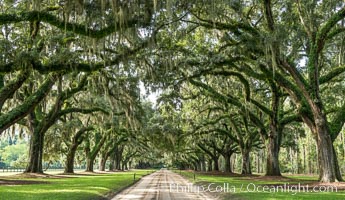
Oak Alley at Boone Hall Plantation, a shaded tunnel of huge old southern live oak trees, Charleston, South Carolina.
Species: Southern live oak, Quercus virginiana
Location: Boone Hall Plantation, Charleston, South Carolina
Image ID: 37397
Species: Southern live oak, Quercus virginiana
Location: Boone Hall Plantation, Charleston, South Carolina
Image ID: 37397
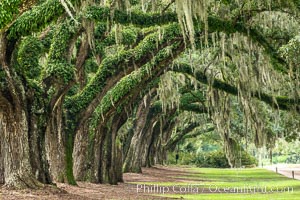
Oak Alley at Boone Hall Plantation, a shaded tunnel of huge old southern live oak trees, Charleston, South Carolina.
Species: Southern live oak, Quercus virginiana
Location: Boone Hall Plantation, Charleston, South Carolina
Image ID: 37403
Species: Southern live oak, Quercus virginiana
Location: Boone Hall Plantation, Charleston, South Carolina
Image ID: 37403
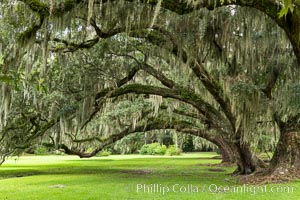
Southern Live Oaks form a shady canopy, Magnolia Plantation, Charleston, South Carolina.
Species: Southern live oak, Quercus virginiana
Location: Magnolia Plantation, Charleston, South Carolina
Image ID: 37406
Species: Southern live oak, Quercus virginiana
Location: Magnolia Plantation, Charleston, South Carolina
Image ID: 37406
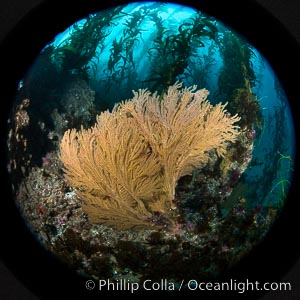
Garibaldi and California golden gorgonian on underwater rocky reef, San Clemente Island. The golden gorgonian is a filter-feeding temperate colonial species that lives on the rocky bottom at depths between 50 to 200 feet deep. Each individual polyp is a distinct animal, together they secrete calcium that forms the structure of the colony. Gorgonians are oriented at right angles to prevailing water currents to capture plankton drifting by.
Species: California golden gorgonian, Giant kelp, Muricea californica, Macrocystis pyrifera
Location: San Clemente Island, California
Image ID: 38501
Species: California golden gorgonian, Giant kelp, Muricea californica, Macrocystis pyrifera
Location: San Clemente Island, California
Image ID: 38501
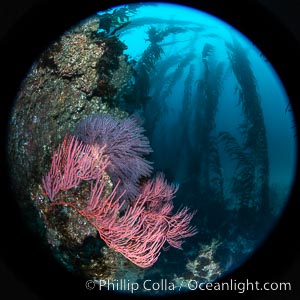
Red gorgonian on rocky reef, below kelp forest, underwater. The red gorgonian is a filter-feeding temperate colonial species that lives on the rocky bottom at depths between 50 to 200 feet deep. Gorgonians are typically oriented at right angles to prevailing water currents to capture plankton drifting by.
Species: Red gorgonian, Giant kelp, Brown gorgonian, Leptogorgia chilensis, Lophogorgia chilensis, Macrocystis pyrifera, Muricea fruticosa
Location: San Clemente Island, California
Image ID: 38502
Species: Red gorgonian, Giant kelp, Brown gorgonian, Leptogorgia chilensis, Lophogorgia chilensis, Macrocystis pyrifera, Muricea fruticosa
Location: San Clemente Island, California
Image ID: 38502
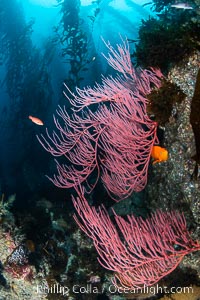
Red gorgonian on rocky reef, below kelp forest, underwater. The red gorgonian is a filter-feeding temperate colonial species that lives on the rocky bottom at depths between 50 to 200 feet deep. Gorgonians are typically oriented at right angles to prevailing water currents to capture plankton drifting by.
Species: Red gorgonian, Giant kelp, Leptogorgia chilensis, Lophogorgia chilensis, Macrocystis pyrifera
Location: San Clemente Island, California
Image ID: 38503
Species: Red gorgonian, Giant kelp, Leptogorgia chilensis, Lophogorgia chilensis, Macrocystis pyrifera
Location: San Clemente Island, California
Image ID: 38503
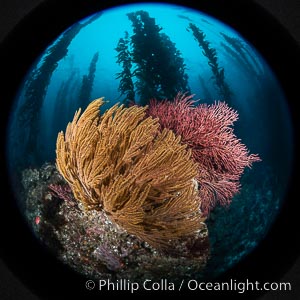
Garibaldi and California golden gorgonian on underwater rocky reef, San Clemente Island. The golden gorgonian is a filter-feeding temperate colonial species that lives on the rocky bottom at depths between 50 to 200 feet deep. Each individual polyp is a distinct animal, together they secrete calcium that forms the structure of the colony. Gorgonians are oriented at right angles to prevailing water currents to capture plankton drifting by.
Species: California golden gorgonian, Giant kelp, Muricea californica, Macrocystis pyrifera
Location: San Clemente Island, California
Image ID: 38504
Species: California golden gorgonian, Giant kelp, Muricea californica, Macrocystis pyrifera
Location: San Clemente Island, California
Image ID: 38504
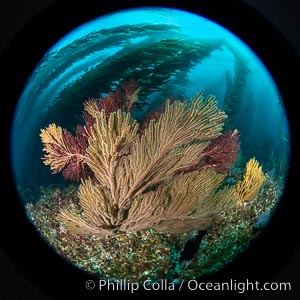
Garibaldi and California golden gorgonian on underwater rocky reef, San Clemente Island. The golden gorgonian is a filter-feeding temperate colonial species that lives on the rocky bottom at depths between 50 to 200 feet deep. Each individual polyp is a distinct animal, together they secrete calcium that forms the structure of the colony. Gorgonians are oriented at right angles to prevailing water currents to capture plankton drifting by.
Species: California golden gorgonian, Giant kelp, Muricea californica, Macrocystis pyrifera
Location: San Clemente Island, California
Image ID: 38509
Species: California golden gorgonian, Giant kelp, Muricea californica, Macrocystis pyrifera
Location: San Clemente Island, California
Image ID: 38509
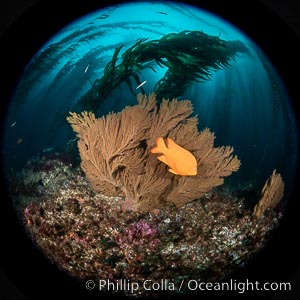
Garibaldi and California golden gorgonian on underwater rocky reef, San Clemente Island. The golden gorgonian is a filter-feeding temperate colonial species that lives on the rocky bottom at depths between 50 to 200 feet deep. Each individual polyp is a distinct animal, together they secrete calcium that forms the structure of the colony. Gorgonians are oriented at right angles to prevailing water currents to capture plankton drifting by.
Species: California golden gorgonian, Giant kelp, Garibaldi, Muricea californica, Macrocystis pyrifera, Hypsypops rubicundus
Location: San Clemente Island, California
Image ID: 38510
Species: California golden gorgonian, Giant kelp, Garibaldi, Muricea californica, Macrocystis pyrifera, Hypsypops rubicundus
Location: San Clemente Island, California
Image ID: 38510
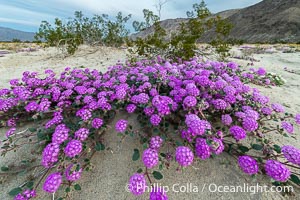
Desert Sand Verbena near Henderson Canyon Road During Unusual Winter Bloom in January, fall monsoon rains led to a very unusual winter bloom in December and January in Anza Borrego Desert State Park in 2022/2023.
Location: Anza-Borrego Desert State Park, Borrego Springs, California
Image ID: 39033
Location: Anza-Borrego Desert State Park, Borrego Springs, California
Image ID: 39033
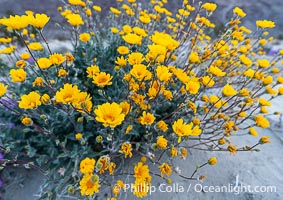
Desert Sunflower in the Coyote Canyon Wash During Unusual Winter Bloom in January, fall monsoon rains led to a very unusual winter bloom in December and January in Anza Borrego Desert State Park in 2022/2023.
Location: Anza-Borrego Desert State Park, Borrego Springs, California
Image ID: 39034
Location: Anza-Borrego Desert State Park, Borrego Springs, California
Image ID: 39034
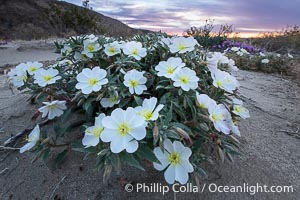
Dune Evening Primrose in the Coyote Canyon Wash During Unusual Winter Bloom in January, fall monsoon rains led to a very unusual winter bloom in December and January in Anza Borrego Desert State Park in 2022/2023.
Location: Anza-Borrego Desert State Park, Borrego Springs, California
Image ID: 39035
Location: Anza-Borrego Desert State Park, Borrego Springs, California
Image ID: 39035
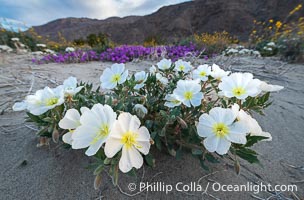
Dune Evening Primrose in the Coyote Canyon Wash During Unusual Winter Bloom in January, fall monsoon rains led to a very unusual winter bloom in December and January in Anza Borrego Desert State Park in 2022/2023.
Location: Anza-Borrego Desert State Park, Borrego Springs, California
Image ID: 39036
Location: Anza-Borrego Desert State Park, Borrego Springs, California
Image ID: 39036
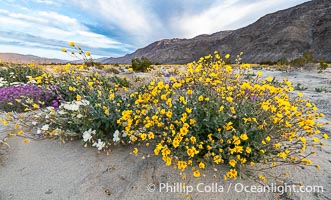
Desert Sunflower in the Coyote Canyon Wash During Unusual Winter Bloom in January, fall monsoon rains led to a very unusual winter bloom in December and January in Anza Borrego Desert State Park in 2022/2023.
Location: Anza-Borrego Desert State Park, Borrego Springs, California
Image ID: 39037
Location: Anza-Borrego Desert State Park, Borrego Springs, California
Image ID: 39037
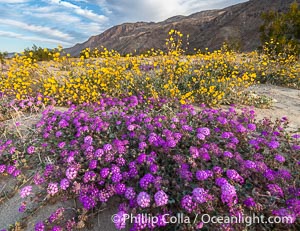
Mixed Wildflowers in the Coyote Canyon Wash During Unusual Winter Bloom in January, fall monsoon rains led to a very unusual winter bloom in December and January in Anza Borrego Desert State Park in 2022/2023.
Location: Anza-Borrego Desert State Park, Borrego Springs, California
Image ID: 39038
Location: Anza-Borrego Desert State Park, Borrego Springs, California
Image ID: 39038
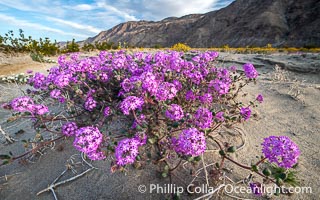
Desert Sand Verbena During Unusual Winter Bloom in January, fall monsoon rains led to a very unusual winter bloom in December and January in Anza Borrego Desert State Park in 2022/2023.
Location: Anza-Borrego Desert State Park, Borrego Springs, California
Image ID: 39039
Location: Anza-Borrego Desert State Park, Borrego Springs, California
Image ID: 39039
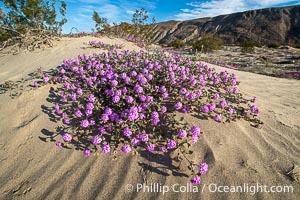
Desert Sand Verbena in the Coyote Canyon Wash During Unusual Winter Bloom in January, fall monsoon rains led to a very unusual winter bloom in December and January in Anza Borrego Desert State Park in 2022/2023.
Location: Anza-Borrego Desert State Park, Borrego Springs, California
Image ID: 39040
Location: Anza-Borrego Desert State Park, Borrego Springs, California
Image ID: 39040
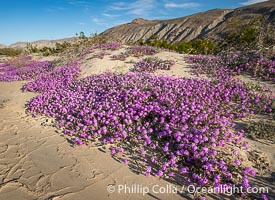
Desert Sand Verbena in the Coyote Canyon Wash During Unusual Winter Bloom in January, fall monsoon rains led to a very unusual winter bloom in December and January in Anza Borrego Desert State Park in 2022/2023.
Location: Anza-Borrego Desert State Park, Borrego Springs, California
Image ID: 39041
Location: Anza-Borrego Desert State Park, Borrego Springs, California
Image ID: 39041
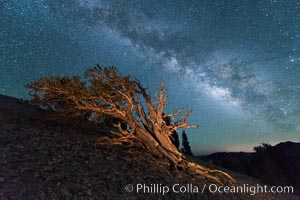
Milky Way over Ancient Bristlecone Pine Trees, Inyo National Forest.
Species: Bristlecone pine, Pinus longaeva
Location: Ancient Bristlecone Pine Forest, White Mountains, Inyo National Forest, California
Image ID: 29319
Species: Bristlecone pine, Pinus longaeva
Location: Ancient Bristlecone Pine Forest, White Mountains, Inyo National Forest, California
Image ID: 29319
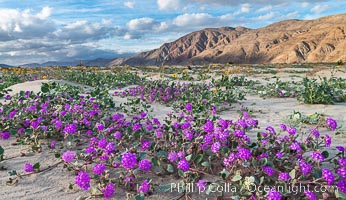
Sand verbena wildflowers on sand dunes, Anza-Borrego Desert State Park.
Species: Sand verbena, Abronia villosa
Location: Anza-Borrego Desert State Park, Borrego Springs, California
Image ID: 30495
Species: Sand verbena, Abronia villosa
Location: Anza-Borrego Desert State Park, Borrego Springs, California
Image ID: 30495
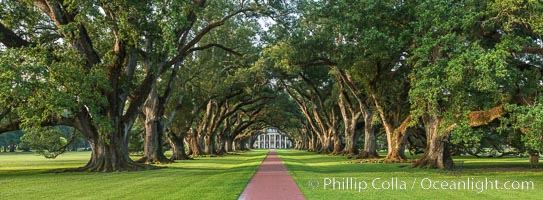
Oak Alley Plantation and its famous shaded tunnel of 300-year-old southern live oak trees (Quercus virginiana). The plantation is now designated as a National Historic Landmark.
Species: Southern live oak, Quercus virginiana
Location: Oak Alley Plantation, Vacherie, Louisiana
Image ID: 31018
Panorama dimensions: 6564 x 17803
Species: Southern live oak, Quercus virginiana
Location: Oak Alley Plantation, Vacherie, Louisiana
Image ID: 31018
Panorama dimensions: 6564 x 17803